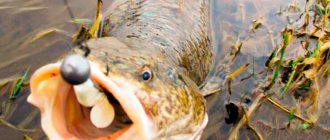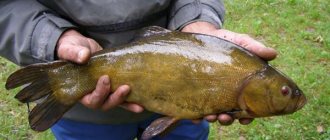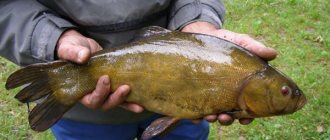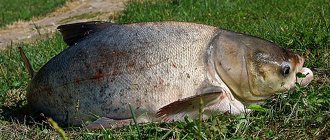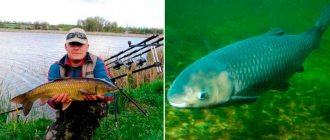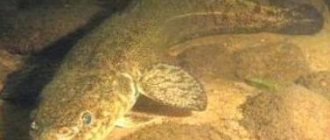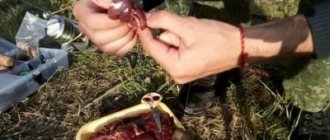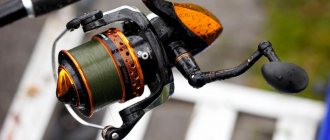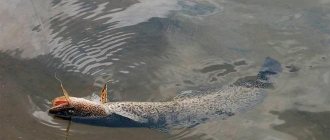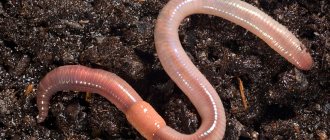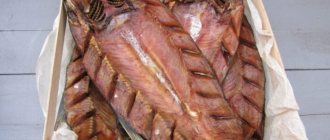Author of the article
Andrey Soprykin
Professional fisherman with 23 years of experience.
Articles written
85
When the autumn season arrives, many novice fishermen begin to look for the basic methods of catching burbot. The fish is considered to be the only genus of cod that can be found in freshwater rivers. The characteristic features of the fish make catching it a relatively exceptional action.
It is especially problematic to catch it in the warmer period of the year; it almost does not leave its own parking area - in similar cases, this fish is in some cases caught by hand. This cold-loving fish means catching burbot in the autumn and spring, but in addition, ice fishing will become more effective.
Fishing is especially good in late autumn. This fish is distributed relatively equally in the middle zone, although it is not found in many rivers, which indicates water contamination with industrial waste.
Burbot loves rivers with the purest water, but also with a good flow and a rocky bottom. Fish are found in holes with cool springs, near snags, pebbles, but also often hidden in the roots of trees that grow near water (it has been recorded that if trees growing along the banks of a river are cut down, in this case it is often from such areas the fish is removed).
Expert opinion
Valery Andreevich Sizov
Professional fisherman with 35 years of experience
Important!!! The best period for catching burbot begins if the water temperature does not exceed 12°-13°C. When 15°C approaches, the dynamism rapidly decreases, and this animal also seeks shelter at the bottom, where it waits out the warmer period of the year.
Another unusual feature is the spawning period. For this carnivore, it occurs in the winter; the burbot bite in these months is poor; if they are caught, it is only small specimens.
Burbot fishing in autumn is one of the best seasons. This dark beast uses its eyes almost in no way, but relies on the scent of prey, as well as information that it acquires with the help of frontal directions. Due to such distinctive features of the fish's action, catching burbot in October and right up to freeze-up is considered more promising due to the significant initiative of the fish.
Baits and groundbait
Since burbot is a carnivorous fish, the bait must be, like fish bait, made from animal parts. The following baits are used: maggots, bloodworms, reddish earthworms, live bait, also active frogs, pieces of fish. For the purpose of baiting, the same elements are used as bait.
It is ineffective to use lean elements for carnivorous fish. There are a number of alternatives for delivering this kind of bait to the fishing site. Feeders use specialized closing feeders that have a series of small holes.
Thanks to their active feeding, like maggots, it takes a long time to get out of the feeder into the reservoir, and also makes it possible to keep fish in a certain area for a long time. Another type is bait flashers, which are produced from the soil. Inside the ball there is an active bait, which after the ball falls into the river will be washed away by water.
Fishing with capelin
Among a wide range of baits, capelin shows good results. Towards the end of autumn, anglers use pipe cleaners as bait. The reason for this is easy accessibility.
Expert opinion
Valery Andreevich Sizov
Professional fisherman with 35 years of experience
This is interesting!!! Dead small fish such as roach and bleak are also considered quite catchable bait. And so much so that in some conditions burbot gives them greater preference than active, lively bait.
This is because burbot is a representative of sedentary, lazy fish, which is sometimes too lazy to chase passing fish. At the same time, the fisherman must understand the following: when using lifeless fish as bait, it must be purchased at a stall as fresh produce.
There is a myth circulating among fishermen that burbot responds well to slightly rotten food. In fact, this is far from the case. Fish sometimes negatively perceive the smell of rotten meat, thinking that such food will primarily harm rather than support its body.
Expert opinion
Valery Andreevich Sizov
Professional fisherman with 35 years of experience
Important!!! Catching burbot in the fall with capelin is the most famous method among anglers. This bait is used throughout the autumn and winter seasons. At this time, burbot is preparing to spawn, requiring an increased amount of food.
At the moment of zhora, you can eat a bunch of worms, but finding them is quite problematic. To increase your fishing success, you should acquire several bait options in advance. Relaxed, with an emphasis on capelin.
Capelin is always available in every grocery store that has a fish section. If you don’t have small attachments on hand, you can cut the larger one in half. If the size is not large, a single nozzle will do. Again, this is a case-by-case matter.
To make the capelin more attractive, place it on the ground and gently press the head. Therefore, experienced fishermen recommend not purchasing capelin if there is no head.
The reason is the fishy aroma, as it becomes more tempting to predators.
Defrosting capelin is not necessary. Once you purchase a bait, you can immediately go fishing. Do not be afraid that the nozzle will remain hard until the time of immersion under water. Due to the difference between the temperature of the water and the nozzle itself, the latter will acquire the required state under water.
Many fishermen recommend putting capelin on a hook. This is nothing more than a myth that deserves a quick refutation. Professionals, like amateur fishermen, first put the bait on the fishing line, leaving the hook bare. The specificity of hunting for food is that after swallowing the delicious capelin, the burbot has nothing left to do except swallow the hook.
To increase your catch rate, we advise you to pay attention to the tips given below. When purchasing a nozzle, be sure to monitor its quality. It should not be expired or emit an unpleasant rotten smell. This will instantly scare away the predator.
Considering that burbot has a large mouth, the bait must be moderately large. The best size is from 7 to 15 centimeters. If only large capelin is available, it needs to be cut in half. When fishing for burbot, the color of capelin does not have any meaning. The most basic criterion by which burbot determines the quality of the prey is smell. With its support, the fish has a small quality of vision.
What do burbot bite on?
The main bait for burbot is a large bunch of worms.
The following baits work:
- fresh chicken liver;
- goby, gudgeon, both alive and dead;
- dead fish;
- fish tripe.
When fishing with dead fish, they must be cut across, along with the head.
The bait can be treated with an attractant, such as worm extract, mussel extract, fish oil and Asian fish sauce work well. You can either spray them onto the bait or put the bait there for a couple of hours.
If you don't have fish from your local pond, try fish from the supermarket, such as a piece of herring, or any other fish. They need to be cut into large pieces.
Use fresh fish; although burbot can be caught with stale fish, it is, in my opinion, bad, especially if there is a sufficient food supply in the reservoir.
If you use a feeder instead of a weight, there is no point in pouring any bait into it.
Place a foam sponge soaked in a mixture of attractants from the list above; it will attract him, since these fish have a well-developed sense of smell. The smell spreads quickly in the water and attracts migrating predators even from great distances.
The best bite for burbot is before and after spawning. Depending on the region, their spawning begins from November to March.
In each region, the spawning period is different, and in winter there is a ban during these periods; check it in the Fishing Rules to avoid problems with the law.
At this time, males gather in the shallows, near the coastline and actively feed. Closer to spawning, females come to these places. In such places you can find both large burbot and quite small ones, so the tackle must be ready to cope with a trophy specimen.
We recommend: Review of fireflies and alarms for night fishing from AliExpress
After spawning, they go to places with the main current and begin to descend to the depths, to places where they will spend the warm season. Before this, they also actively fatten up.
Donk fishing
Donka is one of the most common and publicly available fishing gear. The most basic ones do not call for having a rod with a reel. Donka is a tackle made only from a fishing line with a hook and sinker. It is very affordable and does not require simple, strange spinning reels and fiberglass telescopic spinning rods.
A large number of anglers choose to use them directly. Catching burbot in October is a more promising species, so as the water temperature dropped, the carnivore also got a bite.
Expert opinion
Valery Andreevich Sizov
Professional fisherman with 35 years of experience
The load for the donkey is chosen based on the power of the current in the fishing area. It is better to choose a hook that is long, and also not of small volume. The burbot bite is not strong at all, but it swallows the bait thoroughly. For this reason, in addition to optimal hooks, it is preferable to have tools for their removal.
A more promising period for this type of fishing is at night, especially in the summer. It is more correct to throw a series of donks in various promising areas, and also control them from time to time - this type of fish bites quite slowly, and in certain cases it is possible to see the bite accordingly, this kind of gear like a donka can be problematic.
How to catch burbot
Burbot are always caught from the bottom using bottom gear. Heavy carp rods with a sinker or feeder weight from 30 to 200 grams, depending on the strength of the current, are best suited for fishing.
Monofilament with a diameter of 0.35 mm is used as fishing line. Braided fishing line is not suitable due to the possibility of icing and loss of all its properties.
Hooks should be strong, sharp and large in size, such as four or six.
Advice: use hooks made of stainless wire; it has been noticed that ordinary hooks begin to quickly rust when they come into contact with the mouth of a burbot.
Burbot swallows bait deeply, so there is no point in releasing it, as it will be severely damaged. In this situation, round hooks help, they grab it by the front part of the mouth and it is easy to remove it without damage and release it if its size is smaller than that allowed by the Fishing Rules.
Advice: Burbot has a distinctive feature from other fish, it is attracted by light, I recommend using a flashlight on the shore, aimed at the coastal zone, or attaching a luminous element to the equipment, for example, fireflies for floats, they need to be secured in a heat-shrinkable white or transparent tube, so so that they do not tangle the tackle, or secure it to the sinker.
A serious problem when fishing for burbot, it has unnoticeable bites. Neither bells nor electronic bite alarms help. This is due to the fact that after swallowing prey, burbots like to remain in place for some time and not move anywhere.
We recommend: Fishing for carp in April and May on paid fishing grounds
Sometimes it happens that having swallowed the bait, he begins to move with it, without trying to get rid of it, feeling the prick from the hook, and can easily drag your rod with him, since the fish is quite strong.
If you notice a bite, start fishing immediately, as the burbot will begin to go into hiding, where it will definitely catch your load or feeder, and you will lose both fish and equipment.
If you feel that you are caught, do not try to pull the tackle out by force. Wait a while and keep the line tensioned, the burbot may come out of the shelter on its own, and at that moment you can pull it out.
Assembly for catching burbot
The assembly for catching burbot is quite simple, but there are certain requirements for it:
- When biting, burbot often begins to drag the assembly along the bottom and stones, which is why it gets stuck in the stones and jams; for this reason, use a monofilament line with a diameter of 0.30 - 0.25 mm. In case of problems, it can be torn off relatively easily in a controlled manner.
- Fluorocarbon with a diameter of 0.25 mm and a length of 1 to 1.5 m is best suited as a leash.
- Sinkers and feeders should be smooth and should press the bait tightly to the bottom.
The assembly is used as in the photo below; a regular paternoster works just as well.
Assembly for catching burbot
The reservoir should be fished in a checkerboard pattern; the bait is best placed next to stones or at the edge of the current. Use several rods for fishing.
The bites begin at dusk and continue for several hours. Then there comes a break and towards the middle of the night it starts again.
Fishing with a zherlitsa
If the reservoir is covered with ice and it is not possible to fish with a feeder, use girders.
When fishing for burbot, there is no point in using rigs with alarms; a regular reel with fishing line and higher equipment is suitable. The baits and attractants used are the same as described above.
An example of my homemade zherlitsa in the photo below:
Zherlitsa for burbot
As a reel, I use a spool of nylon thread; on a pond, it is inserted into any stick of suitable diameter, and so that it does not freeze, it is covered with snow. A loop on the reel is used as a signaling device, photo below, but unfortunately, it does not show exactly whether there is a fish on the hook or not, since burbot can eat the bait and stand still, the most effective way is to just walk and check the girders every 15-30 minutes .
Bite alarm on a burbot bait
The reel can be replaced with a piece of rubber garden hose, it works the same way, even more convenient, especially in severe frost, but the hose must be tied at one end to a stick and completely lowered into the water, and the thread will come off from the other open end.
We recommend: Fishing ban dates in 2021
Instead of fishing line, I use thick-diameter nylon thread; it is strong enough and does not cut your hands when removing fish from a hole or from a shelter, making fishing comfortable and injury-free.
To mark holes, flags or pieces of sticks from a pond are used so that the hole does not freeze, it is simply covered with snow.
When fishing for burbot from the ice, always take an ice pick with you, as the size of the caught fish can be very large and you will not be able to pull it out of the hole.
The only problem with girders of this type may be with the Fishing Supervision Authority, do not go far from them, and control them, as otherwise they turn into a passive means of fishing, or supplies, which are prohibited in recreational fishing. True, they are prohibited only when fishing in salmon habitats, but for some reason fish inspectors forget about this. Unfortunately, the legislation does not define the difference between a zherlitsa and a supplier.
Spinning fishing
In the summer season, it is very difficult to catch burbot, due to the low initiative of the fish. In some cases, spinning fishing is justified at night in shallow-bottomed places. Here, in addition to burbot, it is often possible to catch pike perch if you fish with a foam fish.
In the summer season there is only one other fishing method. During the warmer period of the year, burbot is lifeless, dormant, hiding from the heat in various shelters. During this period, it is caught directly in burrows and near stones by hand.
If this fish is touched, it is often in no hurry to escape, but only strives to squeeze deeper into its own shelter . Spinning is not a very comfortable rod for catching burbot, since the main thing to do is to catch it at night.
If the energy of the fish increases, and casting in the dark is very uncomfortable. Spinning, swaying spinners, edible polymer, and foam fish are also used. Numerous fishermen choose to hunt directly for foam fish, perhaps filling it with juice from minced fish in order to give a good catch.
Instead of an artificial bait, it is possible to use live bait, but you need to take into account that the presence of spinning fishing will not last for long. It is necessary to fish not in pits and other deep zones.
On the contrary, there are shallow waters up to 3 meters deep, where fish crawl out to eat. The best criteria for fishing would be a moonless night with mushroom rain. In calm weather on a clear moon at night, this carnivorous fish is inactive.
Fishing for burbot in spring
Fishing for burbot in the spring on a donk begins very early, as soon as the rivers open up from ice. It happens that while fishing, lonely ice floes float past the gear, washed by the current from some quiet bay of the river. The water is even greater and often the banks of catchable burbot reaches, from which burbot were caught in the fall, are flooded. And this is often the main difficulty in catching a nocturnal predator in early spring. Sometimes you just don’t approach the river in the right place. And when the spring river enters the banks, which happens when the weather gets warmer, the burbot stops taking.
Unlike most fish, which require water no colder than fifteen degrees for normal activity, this freshwater representative of cod living in the icy fjords of Norway, on the contrary, requires cold water. In summer, burbot sleepily doze in holes and under heavy oak trees, near springs gushing from the bottom, in the coldest and deepest holes. Only in October-November does the nocturnal predator come out to the reaches again and begin to eat small fish, preparing for the imminent spawning.
Donks are mainly used for catching burbot. Some people use spinning tackle, where instead of a heavy spoon, they use a sinker with one or two leashes. Others use a feeder and a picker, with which during the day they catch various spring fish going to spawn, and at night they catch burbot with the same gear, unfastening the feeder and replacing it with a sinker, or leaving everything as is. Often the feeder is also filled with bait, since in other places at night bream or white-eye sop may approach. And burbot bites can alternate with bites of “white” fish.
Catching burbot in the spring on a donk, as already mentioned, is carried out by a variety of types of these donks. But the most suitable and frequently used gear for catching burbot are hooks. When fishing at night in early spring, when frosts are common, these simple gears work more efficiently. There is no need to fuss with thin rigs, replacing leashes with fingers that get cold in the icy wind or tying hooks. And breakages of gear in the spring are inevitable, since the current brings driftwood and entire bushes washed away on the banks. In addition, large melt water covers willow thickets and other “strong” places where not only hooks, but also sinkers can be torn off.
A zakidushka is a bottom tackle with a reserve of main fishing line at least 50 m long and wound on a plastic or wooden reel. At the end of the main line, a heavy sinker weighing about 200 grams is attached, and often heavier, as spring conditions require, and above that - one or two leashes. Since burbot always takes the hook closest to the sinker, it is more logical to use only one leash. But sometimes there is a need for two leashes, although they get tangled more when casting. However, it is more effective to use two baits on one tackle: worms and live bait or cutting bait. Larger fish are caught on cutting or live fish, although bites are less common than on worms. That’s why you should combine baits. For full operation of the hook, one leash can be secured below the sliding sinker, and the other tied 8–10 centimeters above it. Both hooks will be on the bottom with this method of attaching leashes. The length of the leashes is about 30 cm.
The hooks are simple and somewhat rough gear. And this does not affect the success of fishing. The diameter of the main fishing line can be 0.5–06 mm. A regular monofilament line is used. A 0.3 mm fishing line is placed on the leashes. The hooks are large, preferably with a long shank, No. 1, No. 1/0.
It is often difficult or almost impossible to cast a tackle from a bank overgrown with bushes or grass. The casting line will cling to all these thickets. Here you can use either a spinning reel on a short rod, or use the simplest analogue of a “spinning reel” by winding the fishing line on a plastic bottle from Actimel or something similar from this type of plastic product.
The most common bait for spring are worms and live bait, as well as cut fish.
Catching burbot in the spring on a donk, in addition to being one of the earliest in open water, is also very romantic and mysterious, since the action often takes place on moonlit nights under the hooting of an eagle owl and the murmur of icy river streams.
Fishing on a feeder
Fishermen also use feeder rods. Their receptive tips will make it possible to timely notice a burbot bite, which can also be missed on less receptive gear.
The length of the fishing rod is also selected based on the fishing circumstances, but for this purpose, you should understand the zones in which the fish like to feed at night and relax during the day. If promising places are close to the shore, then using a simple picker up to 3 meters long will be absolutely sufficient.
If the purpose of fishing is not far from the shore, but there is still a very significant current in the reservoir, then it would be more correct to use the most serious feeder, with a length of more than 3 m and a weight of more than 120 grams.
Expert opinion
Valery Andreevich Sizov
Professional fisherman with 35 years of experience
Important!!! Fishing with a feeder is one of the more successful, because the fish quickly become saturated during this period of lowering the water temperature and atmosphere. Production in September depends on the atmospheric and water temperature. If the cold snap occurs earlier, it is possible to rely on production.
Numerous fishermen believe that catching burbot in the fall is more effective in the interval between the main frosts and freeze-ups. Fishing in October often depends on fairly low temperatures. If you liked the material you read, please share it with your friends.
